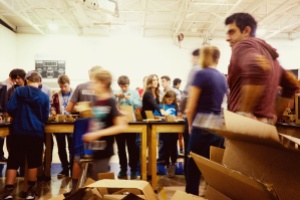 March is makerspace month here at CMLE! This month we’ll have a series of blog posts with the makerspace theme. This week we learn that makerspaces aren’t just for schools.
March is makerspace month here at CMLE! This month we’ll have a series of blog posts with the makerspace theme. This week we learn that makerspaces aren’t just for schools.
A lot of the buzz around makerspaces seems to be about school libraries. But academic and public libraries are getting into the action too! From 3D printers to edible book festivals, many academic libraries have had makerspaces, except by name, for years. And who doesn’t think of their local public library and not think of the children’s area where kids can play and explore.
Academic:
Many in academia will quickly dismiss makerspaces due to their lack of obvious pedagogy learning goals. However, others see a move beyond Fixed-Choice Tests into Performance Assessment – which can sound a little like makerspaces. “In the performance assessment paradigm, learning is an active process in which “students construct meaning and knowledge: they do not have meaning or knowledge handed to them in a book or lecture,” says Megan Oakleaf. “Learning, then, is a process of students ‘making sense’ of how things fit together…” (DOI: 10.1353/pla.0.0011 ). Even Megan Lotts’ recent article: Implementing a culture of creativity: Pop-up making spaces and participating events in academic libraries dug deeper in to the Academic Makerspace.
Public:
One local example where public libraries are getting into the makerspace business is with Smart Play Spots and a partnership with the Minnesota Children’s Museum. Smart Play Spots are learning environments that encourage children’s “literacy development through hands-on, multi-sensory activities that include dramatic play, story telling, and playing with letters and sounds.” You can read more about the program here. From play areas to 3D printers, public libraries are joining the makerspace fun!
Let us know how you’re using makerspaces in your academic or public library!
Image credit: http://tinyurl.com/l92kuy3, licensed under CC BY-NC-ND 2.0
